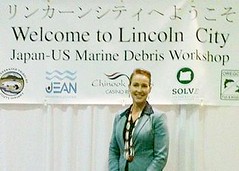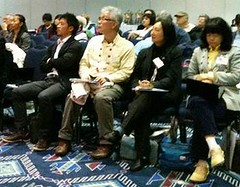311海嘯廢墟 仍有150萬噸在海上漂流
 由於2011年3月日本地震與海嘯所造成廢墟散佈在太平洋各處,關心此議題的日本環保人士17日前往美國林肯市,與當地居民合作共同清理奧勒岡州的海灘。
由於2011年3月日本地震與海嘯所造成廢墟散佈在太平洋各處,關心此議題的日本環保人士17日前往美國林肯市,與當地居民合作共同清理奧勒岡州的海灘。
像是要迎接他們的到來似的,就在日本代表團抵達的前幾天,一艘佈滿藤壺、殘破不堪的日本漁船被沖刷到奧勒岡海岸南邊五英里的海灘上。經奧勒岡魚類與野生動物保護署的學者檢查上面附著的外來物種後,這搜重達一噸的漁船已被拖到當地的垃圾掩埋場。
從2012年開始,海嘯廢墟出現在夏威夷的海灘,而美國本土從阿拉斯加到加州也都有廢墟出現。兩座大型碼頭被沖上岸,一座於2012年8月在奧勒岡海岸距林肯市南方約20英里處被發現,另一座則是在2012年12月被沖到華盛頓州的奧林匹克半島上,另外還有更多小型的殘骸,如釣烏賊用的漁燈、塑膠垃圾等,從日本飄洋過海而來。
來自日本的環保人士與奧勒岡的夥伴17日共同在林肯市的度假勝地舉辦了海灘淨化活動,並在16日進行了一整天關於海洋廢墟的公眾工作坊,參加者包括了許多當地官員與各年齡層志工。
 奧勒岡州長夫人Cylvia Hayes歡迎日本環保人士們的到訪,她表示日本團體的到來對她和奧勒岡的人民來說都很重要。
奧勒岡州長夫人Cylvia Hayes歡迎日本環保人士們的到訪,她表示日本團體的到來對她和奧勒岡的人民來說都很重要。
她在受ENS訪問時說道:「我是推動政府實際成立海嘯廢墟處理專案小組的其中一人,我同時也和SOLVE與Surfrider等團體聯繫,他們在早期就把握機會開始從事這個議題的教育宣導。」
Hayes是3EStrategies環境顧問公司的創辦人兼執行長。作為州長夫人,她和州長John Kitzhaber已經組了數次貿易代表團前往日本。
Hayes表示,「我關心海洋議題已經有很長的一段時間,海嘯廢墟帶出了幾個我所擔心的問題,其一便是我們和鄰居日本之間的關係,而另外一個當然就是飄散在海洋中的大量塑膠垃圾。」
Hayes致力於淨灘、為團體舉辦與海嘯廢墟相關的會議和演說,還針對這個議題錄了一段公眾宣導短片。她說:「事實上,我不覺得我現在的角色很重要,因為我們有一個相當好的組織結構,並且也正順利的運行中。海岸的社群團體做得非常好,SOLVE和Surfrider也和奧勒崗公園處舉辦了多場清理海灘的活動。」
「對我而言,這些事會讓大家持續關注這個議題,那些日本地區仍舊處於受災的情況當中,他們依然在努力重建原本的生活。看到那些擔心他們會在兩年後被遺忘的感想,讓我非常感動,我現在要做的就是讓大眾持續關心這個議題。」
在接下來的一到兩年,預期將會有更大一波的海嘯廢墟沖到奧勒岡海岸。
日本環境省技術官員Junichiro Noguchi在工作坊指出,約有500萬噸的廢墟在海嘯後被沖入海中,其中350萬噸沉在日本附近的海床,而剩下的150萬噸則持續在海中漂流。
 非政府組織「日本環境行動網」 (JEAN)籌畫了這次到奧勒岡州拜訪之旅。透過這次到訪,JEAN和其他參與的日本團體希望將他們災後重建之付出的情形與美國觀眾分享,並透過此次機會研究在北美沿岸出現的海嘯廢棄物。
非政府組織「日本環境行動網」 (JEAN)籌畫了這次到奧勒岡州拜訪之旅。透過這次到訪,JEAN和其他參與的日本團體希望將他們災後重建之付出的情形與美國觀眾分享,並透過此次機會研究在北美沿岸出現的海嘯廢棄物。
來自JEAN的Azysa Jihuna表示,從1990年開始,他們團體便提供環保資訊給國家政府和社會大眾來解決海洋垃圾問題,他們也會在春秋兩季呼籲大家一起參加淨灘活動。
宮城縣災害重建志工中心負責人Atsunori Nagayama在演說中表示,讓美國人清理日本垃圾,他感到很抱歉,「這就是我從宮城來到這裡的原因,我很願意再來幫助清理林肯市的海灘。」
日本代表團受到奧勒岡居民熱烈歡迎,林肯市市民Bonnie VanBruggen說:「我們家與日本同在北緯45度線上,你是我們在海洋西邊的鄰居。」另外一位居民告訴日本代表團,「謝謝你們來訪,我們愛你。」
奧勒岡災難應變辦公室主任General Mike Caldwell負責帶領奧勒岡海嘯廢墟處理專案小組,他負責處理事件的預防與因應、公共安全、善後,並負責告知人民海洋廢墟對奧勒岡海岸線帶來的影響。
專案小組中包含州警、公園處、環境品質、魚類與野生動物保護署、公眾健康、交通運輸、海事局等單位的代表,另外還有當地和原住民政府、州議員、社區組織和聯邦機構等。
專案小組和211info合作,211info是非營利之電話熱線,他們合作以擴展對海岸周邊社區之涵蓋範圍,來獲得海洋廢墟的相關訊息與報告。民眾可以撥打2-1-1或是1-800-安全-網(1-800-723-3638)來得到相關資源與消息。
「從沖到Agate海灘的碼頭,到逐漸增加的小型殘骸,我們勢必要準備好在接下來的數個月甚至數年間面對範圍更大的問題,我們首先要做的,就是擬好計畫,並準備好必要的資源,以便在事情發生時能快速且有效率的應變,來保全我們社區的安全。」
Japanese environmentalists concerned about marine debris scattered across the Pacific by the March 2011 earthquake and tsunami came to Lincoln City on the weekend to coordinate with Oregon residents and help clean Oregon beaches.
As if to greet them, a barnacle-encrusted, battered fishing boat from Japan washed up on the Oregon shore five miles to the south just a few days before the Japanese delegation arrived. After Oregon Department of Fish and Wildlife scientists examined it for invasive species, the one-ton boat was hauled to a local landfill.
Tsunami debris began showing up on beaches in Hawaii and from Alaska to California last year. Two large docks have washed ashore, one last August in Oregon about 20 miles south of Lincoln City, and the other on Washington’s Olympic Peninsula last December. Many smaller pieces of debris from squid fishing lights to bits of plastic have made their way across the ocean.
The Japanese visitors and their Oregon counterparts held a beach cleanup Friday in the resort town of Lincoln City and a day-long Marine Debris Public Workshop Saturday that drew state and local officials and cleanup volunteers of all ages.
Oregon First Lady Cylvia Hayes welcomed the Japanese group and said their visit is important to her and to the people of Oregon.
“I was part of the movement that got the Governor’s Office to actually set up the Tsunami Debris Task Force,” she told ENS in an interview. “And then also I was in communication with SOLVE and Surfrider and some of those organizations early on to help make the most of this heightened opportunity to educate people about the issue in general.”
Hayes is founder and CEO of 3EStrategies, an environmental consulting firm. In the role of First Lady, she and “life partner” Governor John Kitzhaber have done several trade missions to Japan.
“I’ve been concerned about ocean issues for a long time,” Hayes said. “This tsunami debris issue brought together a couple of different concerns of mine. One is our relationship with our neighbors in Japan and, of course, the vast amounts of plastic trash that we have in our oceans in general.”
Hayes does beach cleanups, convenes and speaks to groups about tsunami debris and has filmed a public service announcement on the issue. “Honestly,” she said, “I don’t think my role is important now, because we have such an amazing network set up and really running it. The coastal communities are doing an amazing job, SOLVE and Surfrider are managing the cleanups with the Oregon Parks Department.”
“For me it will be keeping the issue alive with the public,” she said. “Those Japanese communities are still hammered and are still really struggling to put their lives back together. I was really moved by the comment today that they’re starting to be concerned that they’ll be forgotten two years after. Keeping awareness high is my focus now.”
Over the next year or two, an even greater wave of tsunami debris is expected to wash up on the Oregon coast.
Speaking at the workshop, Junichiro Noguchi, a technical official from Japan’s Ministry of the Environment, said about five million tons of debris entered the ocean after the tsunami. Some 3.5 million tons of that debris has settled into the sea bed near Japan, while the remaining 1.5 million tons is drifting in the ocean.
The Japan Environmental Action Network, a nongovernmental organization, coordinated the visit to Oregon. Through this visit, JEAN and the other participating Japanese organizations want to share information about their disaster recovery efforts with U.S. audiences and do research on the tsunami debris showing up on North American shores.
JEAN’s Azysa Jihuna said since 1990 the group has been working to solve the marine litter problem by providing information to the national government and Japanese society. To help solve the ocean’s garbage problem, we appeal to the public in the spring and fall to take part in coastal cleanup activities, Jihuna said.
Atsunori Nagayama, director of the Miyagi Disaster Relief Vounteer Center, told workshop participants he feels badly that Americans are cleaning up Japanese debris. “That’s why I came here from Miyagi,” he said. “I would like to come again to help clean up beaches here in Lincoln City.”
The Japanese were greeted warmly by Oregon residents. Lincoln City resident Bonnie VanBruggen said, “Our house is near the 45th parallel directly across from Japan. You’re our neighbors to the west across the ocean.”
Another resident told the group from Japan, “Thank you for coming, we love you.”
General Mike Caldwell, director of Oregon’s Office of Emergency Management, heads the Oregon Tsunami Debris Task Force, charged with incident preparedness and response, public safety, cleanup, and public outreach to address marine debris affecting Oregon’s coastline.
The task force includes representatives of State Police, Parks, Environmental Quality, Fish and Wildlife, Public Health, Transportation and the Marine Board, as well as local and tribal governments, state legislators, community organizations, and federal agencies.
The task force has partnered with 211info, a nonprofit phone hotline, to expand coverage for coastal communities to get information on and report issues related to marine debris. People can dial 2-1-1 and can also call 1-800-SAFE-NET (1-800-723-3638) to access resources and information.
“From the dock that washed ashore at Agate Beach, to increasing amounts of smaller debris showing up on Oregon’s coast, it is clear we will need to be ready to respond to a wide range of issues over the coming months and years,” said General Caldwell. “Our priority from the start has been to ensure we have a plan and the necessary resources in place to respond quickly and effectively to keep communities safe.”
※ 全文及圖片詳見:ENS


